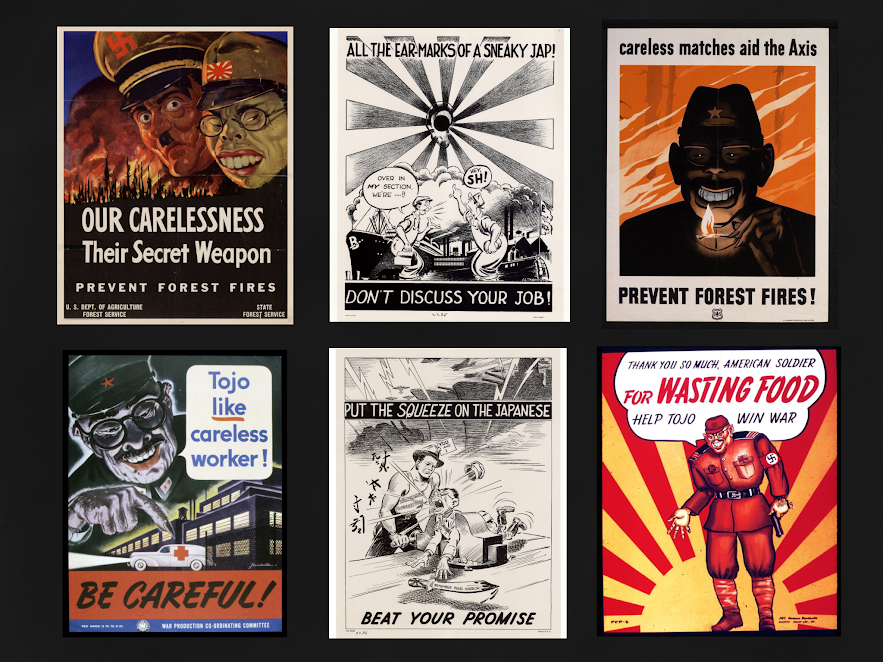Anti-Japanese Propaganda Poster

Curated Anti-Japanese Propaganda Posters

Reflection
Remember Pearl Harbour: The Anti-Japanese Attitude of World War 2
The stereotypes and pessimistic attitude towards Japanese people that grew out of World War II drove US the government to suspend the rights of Japanese Americans, labelling them as the enemy. This made the Japanese American experience isolating and painful. Their suffering was only furthered by the anti-Japanese propaganda being spread to cause paranoia and resentment against them among white Americans. Almost immediately after the Japanese military bombed the US naval base located in Pearl Harbour on December 7, 1941, Japanese Americans became newly classified as enemy aliens. Enemy alien meaning all persons “of Japanese descent suspected of harboring intentions for sabotage or espionage” (Roxworthy 57) living in the US. 10 weeks after the attack, this resulted in the US government imprisoning all people of Japanese ancestry on the West Coast, permanent residents and non citizens alike. “More than 110,000 Japanese Americans were labeled as ‘potentially disloyal’; ordered to leave their homes, careers, and communities; and forced to live in isolated camps located in interior deserts and swamplands” (Nagata et al. 36).
To further my understanding of how propaganda posters made a powerful impact on enforcing stereotypes and exclusionary instincts towards the Japanese, I figured I would make one myself. The majority of the propaganda media were warnings to Americans of the Japanese military. Instead, my poster will be a warning to Americans of their Japanese neighbours. My poster depicts a racist representation of a cynical looking Japanese American poorly trying to convince white Americans that he is trustworthy. In many US propaganda posters illustrators would represent the general, Hideki Tojo, or just a typical Japanese character with threatening and manipulative messages in speech bubbles. I chose to write “Don’t worry fellow Americans, You Can Trust Me!” to stir fear in the hypothetical white American audience. I included key elements of stereotypical Japanese features: buck teeth, squinty eyes, and a yellow complexion. The text at the bottom is telling white Americans to be cautious of the “enemy alien”, referring to any Japanese person in the US. The Japanese were thought to be strategic, and sneaky, therefore, I drew the man with his fingers together, as if he were in the middle of plotting something malicious. He is seen holding a tiny American flag, to seemingly try to be persuasive of his American loyalty even though the Japanese rising sun flag is behind him. Americans were paranoid about “Japanese immigration domestically and their fear of Japanese power internationally, many white Americans developed emotional and deeply ingrained stereotypes about the Japanese” (Campney 847). The sentiment was that the Japanese could never adapt into the ideal patriotic and loyal American ways, the expression “once a Japanese, always a Japanese” was popular. I’m articulating a similar message in my poster, a Japanese man failing at presenting himself as an American and also siding with the stereotypes that all of Japanese descent were born to be unalterably evil.
From being imprisoned behind barbed wire, when the Japanese returned to the West Coast they were encountered with rejection and discrimination. The internment experience created a complication to the Japanese American identity, some wanted to prove how American they were, others sought out amends with their native country. “Later investigations would conclude that the incarceration decision was not a justified military necessity but was instead shaped by ‘race prejudice, war hysteria, and a failure of political leadership’” (Nagata et al. 37). The imposed anti-Japanese attitude and widespread propaganda stuck with white Americans and left them with racial resentment towards the Japanese. Additionally, the repression of Japanese Americans created long lasting detrimental trauma and tainted their American identities. Making the poster helped me understand the propaganda techniques used to hurt and tarnish the nationwide perspective of an entire race.
Reflection Citations
Campney, Brent M. S. “Anti-Japanese Sentiment, International Diplomacy, and the Texas Alien Land Law of 1921.” Journal of Southern History, no. 4, 2019, p. 841. EBSCOhost, search.ebscohost.com/login.aspx?direct=true&db=edsgao&AN=edsgcl.606277496&site=eds-live&scope=site.
Roxworthy, Emily. “The Spectacle of Japanese American Trauma: Racial Performativity and World War II.” University of Hawai’i Press, 2008. JSTOR, www.jstor.org/stable/j.ctt6wqxdf.
Nagata, Donna K et al. “The Japanese American wartime incarceration: Examining the scope of racial trauma.” The American psychologist vol. 74,1 (2019): 36-48. doi:10.1037/amp0000303
Curated Images Citations
Unknown. “Our carelessness, their secret weapon : prevent forest fires.” World War Poster Collection, UNT Digital Library, Government documents no. A 13.20/3:F 51/13, 1943, digital.library.unt.edu/ark:/67531/metadc494.
Alexander. “All the ear-marks of a sneaky Jap! : don’t discuss your job!” World War Poster Collection, UNT Digital Library, digital.library.unt.edu/ark:/67531/metadc160.
Unknown. “Careless matches aid the Axis. Prevent forest fires!” Poster collection. Calisphere, 1942, calisphere.org/item/2df8833386363debe9a2b6977f7d3150/
Miller, Howard. “Tojo like careless worker! Be careful!” Poster collection. Hoover Institution Archives, Stanford, CA, 1941-45, digitalcollections.hoover.org/objects/40398.
Unknown. “Put the squeeze on the Japanese: beat your promise.” World War Poster Collection, UNT Digital Library, 1941-42, digital.library.unt.edu/ark:67531/metadc161
Unknown. “Thank you so much American soldier for wasting food : Help Tojo win war.” Universal Images Group. Universal History Archive, 1942, gettyimages.ca/detail/news-photo/world-war-two-american-anti-japanese-propaganda-poster-news-photo/590677183